What's not to love??? [emoji6]Anybody falling in love with Wrasse? I can't wait to get some new ones for the new tank!
Navigation
Install the app
How to install the app on iOS
Follow along with the video below to see how to install our site as a web app on your home screen.
Note: This feature may not be available in some browsers.
More options
You are using an out of date browser. It may not display this or other websites correctly.
You should upgrade or use an alternative browser.
You should upgrade or use an alternative browser.
The Wrasse Lover's Thread!
- Thread starter Breakin Newz
- Start date
- Tagged users AtulR
Well, I finally made it through this whole thread. I would like to encourage anyone who is thinking about keeping multiple wrasses to read this thread.
I've been in the hobby for several years and feel that I have a reasonably good grasp on saltwater fish, but I learned quite abit from reading this, Evolved's stickies on wrasses, and a few other sites.
Thanks guys for all of the excellent info, plus being extremely patient with people asking the same questions over and over again every few pages of this thread!
I have plenty of questions yet, but will ask them over a period of time.
I've been in the hobby for several years and feel that I have a reasonably good grasp on saltwater fish, but I learned quite abit from reading this, Evolved's stickies on wrasses, and a few other sites.
Thanks guys for all of the excellent info, plus being extremely patient with people asking the same questions over and over again every few pages of this thread!
I have plenty of questions yet, but will ask them over a period of time.
As previously mentioned, I have a 190 with 400G total water volume. I would like to have 10-14 mostly fairy wrasses in the tank adding 2-4 new wrasses at a time.
Using Hunter's wrasse aggression chart from cirrhilabrus-complexes-inferiority-need-not-apply, I am planning on adding juveniles from the different complexes starting with fish from the green complexes, then moving up to the yellow complexes, and then finish out with a few select from the lighter orange color.
My question is:
I am assuming that changing from juvi to terminal male coloration is partially a function of aggression within the tank. If I start with the least aggressive fairies (green complexes) and move up waiting 4-6 months before adding new wrasses that are more aggressive, will it facilitate juvis changing sooner than for instance placing an exquisite in with a Naoke, Randalli, and Laboutei?
Using Hunter's wrasse aggression chart from cirrhilabrus-complexes-inferiority-need-not-apply, I am planning on adding juveniles from the different complexes starting with fish from the green complexes, then moving up to the yellow complexes, and then finish out with a few select from the lighter orange color.
My question is:
I am assuming that changing from juvi to terminal male coloration is partially a function of aggression within the tank. If I start with the least aggressive fairies (green complexes) and move up waiting 4-6 months before adding new wrasses that are more aggressive, will it facilitate juvis changing sooner than for instance placing an exquisite in with a Naoke, Randalli, and Laboutei?
Starting with the more peaceful species is definitely the best course of action and will facilitate the transition. However, it can be a challenge to acquire juveniles and females for many of the fairy species.As previously mentioned, I have a 190 with 400G total water volume. I would like to have 10-14 mostly fairy wrasses in the tank adding 2-4 new wrasses at a time.
Using Hunter's wrasse aggression chart from cirrhilabrus-complexes-inferiority-need-not-apply, I am planning on adding juveniles from the different complexes starting with fish from the green complexes, then moving up to the yellow complexes, and then finish out with a few select from the lighter orange color.
My question is:
I am assuming that changing from juvi to terminal male coloration is partially a function of aggression within the tank. If I start with the least aggressive fairies (green complexes) and move up waiting 4-6 months before adding new wrasses that are more aggressive, will it facilitate juvis changing sooner than for instance placing an exquisite in with a Naoke, Randalli, and Laboutei?
This weekend I'm going to add the 2 Macropharyngodon bipartitus wrasses to my 233 in with 2 Macropharyngodon meleagris. At least start them out in a social acclimation box.
They are all females.
My next attempt would be with getting a Potters Wrasse, Macropharyngodon geoffroyi wrasse.
Then down the road maybe a Kuiter's Leopard Wrasse Macropharyngodon kuiteri.
Is this going to work or am I doomed to failure?
They are all females.
My next attempt would be with getting a Potters Wrasse, Macropharyngodon geoffroyi wrasse.
Then down the road maybe a Kuiter's Leopard Wrasse Macropharyngodon kuiteri.
Is this going to work or am I doomed to failure?
This weekend I'm going to add the 2 Macropharyngodon bipartitus wrasses to my 233 in with 2 Macropharyngodon meleagris. At least start them out in a social acclimation box.
They are all females.
My next attempt would be with getting a Potters Wrasse, Macropharyngodon geoffroyi wrasse.
Then down the road maybe a Kuiter's Leopard Wrasse Macropharyngodon kuiteri.
Is this going to work or am I doomed to failure?
Interested to see what Hunter and TJ say. I've got a well established Potter's and would like to add another Macropharyngodon wrasse.
Seems like a reasonable plan to me.This weekend I'm going to add the 2 Macropharyngodon bipartitus wrasses to my 233 in with 2 Macropharyngodon meleagris. At least start them out in a social acclimation box.
They are all females.
My next attempt would be with getting a Potters Wrasse, Macropharyngodon geoffroyi wrasse.
Then down the road maybe a Kuiter's Leopard Wrasse Macropharyngodon kuiteri.
Is this going to work or am I doomed to failure?
Seems like a reasonable plan to me.
So you think I could add another Macropharyngodon to my established Potters wrasse?
The H. melasmopomus is in QT. Dives in to the sand box and comes out for a short time every few hours. Hard to feed him when it's hard to catch him out. It's only been about 30 hours since he arrived though. I'm sure he'll adapt soon.
I'm curious about the Kuiter's Leopard Wrasse .Seems like a reasonable plan to me.
I don't see much about it, or see people talking about them.
I love the coloration. It's male and female colors are so much different than the other Macropharyngodon wrasses.
It should be ok, potters usually aren't too aggressive.So you think I could add another Macropharyngodon to my established Potters wrasse?
They aren't as commonly kept. They can be on the aggressive side for leopards, so being added last helps.I'm curious about the Kuiter's Leopard Wrasse .
I don't see much about it, or see people talking about them.
I love the coloration. It's male and female colors are so much different than the other Macropharyngodon wrasses.
Seems like a reasonable plan to me.
It just occured to me, but should I put something that could be used as cover in the box?
How about a dish of sand?
Yes, you want them not to be too stressed out, so a little cover is good. A container of sand or some pvc fittings work well.It just occured to me, but should I put something that could be used as cover in the box?
How about a dish of sand?
My new H. melasmopomas has been in QT for a little over 2 days now and is now out and about and feeding well.
I've noticed several hobbiest on this thread that have both lineatus and rubrimarginatus wrasses in their tanks.
I really like both of these wrasses and would love to have them in my tank, but I'm a little cautious considering that they are from the same complex on Evolved's chart.
Just wondering if those of you who keep both could give me a little feedback:
1. How long have you had both in your tank, how big we're they when added, and what kind of tank mates do they have?
2. Do you have any advice on keeping both together in the same tank?
If I put both in my tank, hoping to add them at the same time as juvis with 7-8 wrasses already in the tank. Plus have a few wrasses from the lighter orange groups of wrasses to assure that neither of these develop into the alpha wrasse in the tank.
Taking this one step further, the laboutei complex is connected to the pylei complex with a strong connection. Is adding a laboutes to the mix of the two above something to be concerned of because that they are closely related?
I really like both of these wrasses and would love to have them in my tank, but I'm a little cautious considering that they are from the same complex on Evolved's chart.
Just wondering if those of you who keep both could give me a little feedback:
1. How long have you had both in your tank, how big we're they when added, and what kind of tank mates do they have?
2. Do you have any advice on keeping both together in the same tank?
If I put both in my tank, hoping to add them at the same time as juvis with 7-8 wrasses already in the tank. Plus have a few wrasses from the lighter orange groups of wrasses to assure that neither of these develop into the alpha wrasse in the tank.
Taking this one step further, the laboutei complex is connected to the pylei complex with a strong connection. Is adding a laboutes to the mix of the two above something to be concerned of because that they are closely related?
In a large enough tank with plenty of other wrasses to serve as a distraction, and if added at the same time, and maturity, both the lineatus and rubrimarginatus can be kept together.I've noticed several hobbiest on this thread that have both lineatus and rubrimarginatus wrasses in their tanks.
I really like both of these wrasses and would love to have them in my tank, but I'm a little cautious considering that they are from the same complex on Evolved's chart.
Just wondering if those of you who keep both could give me a little feedback:
1. How long have you had both in your tank, how big we're they when added, and what kind of tank mates do they have?
2. Do you have any advice on keeping both together in the same tank?
If I put both in my tank, hoping to add them at the same time as juvis with 7-8 wrasses already in the tank. Plus have a few wrasses from the lighter orange groups of wrasses to assure that neither of these develop into the alpha wrasse in the tank.
Taking this one step further, the laboutei complex is connected to the pylei complex with a strong connection. Is adding a laboutes to the mix of the two above something to be concerned of because that they are closely related?
I have found that pylei is more aggressive than labouti, and will be dominant. But both can be kept together, though I would recommend it in a tank of 150g or greater.
evolved
[email protected]
View Badges
Excellence Award
Reef Tank 365
Expert Contributor
Article Contributor
Moderator Emeritus
AZ FRAG Member
Hospitality Award
My Tank Thread
As previously mentioned, I have a 190 with 400G total water volume. I would like to have 10-14 mostly fairy wrasses in the tank adding 2-4 new wrasses at a time.
Using Hunter's wrasse aggression chart from cirrhilabrus-complexes-inferiority-need-not-apply, I am planning on adding juveniles from the different complexes starting with fish from the green complexes, then moving up to the yellow complexes, and then finish out with a few select from the lighter orange color.
My question is:
I am assuming that changing from juvi to terminal male coloration is partially a function of aggression within the tank. If I start with the least aggressive fairies (green complexes) and move up waiting 4-6 months before adding new wrasses that are more aggressive, will it facilitate juvis changing sooner than for instance placing an exquisite in with a Naoke, Randalli, and Laboutei?
I agree; that plan should work well, but finding them all at a small size will certainly be a tall order.Starting with the more peaceful species is definitely the best course of action and will facilitate the transition. However, it can be a challenge to acquire juveniles and females for many of the fairy species.
I tend to think you'll be just fine there also.This weekend I'm going to add the 2 Macropharyngodon bipartitus wrasses to my 233 in with 2 Macropharyngodon meleagris. At least start them out in a social acclimation box.
They are all females.
My next attempt would be with getting a Potters Wrasse, Macropharyngodon geoffroyi wrasse.
Then down the road maybe a Kuiter's Leopard Wrasse Macropharyngodon kuiteri.
Is this going to work or am I doomed to failure?
Yes; so long as whatever species you're adding is a female specimen, I wouldn't much worry.So you think I could add another Macropharyngodon to my established Potters wrasse?
Given the size of your tank and the fact you'll have a quite a few wrasses, I wouldn't worry about the compatibility of lineatus and rubrimarginatus. They are more of an issue together in smaller setups, especially if they are the only two wrasses present.I've noticed several hobbiest on this thread that have both lineatus and rubrimarginatus wrasses in their tanks.
I really like both of these wrasses and would love to have them in my tank, but I'm a little cautious considering that they are from the same complex on Evolved's chart.
Just wondering if those of you who keep both could give me a little feedback:
1. How long have you had both in your tank, how big we're they when added, and what kind of tank mates do they have?
2. Do you have any advice on keeping both together in the same tank?
If I put both in my tank, hoping to add them at the same time as juvis with 7-8 wrasses already in the tank. Plus have a few wrasses from the lighter orange groups of wrasses to assure that neither of these develop into the alpha wrasse in the tank.
Taking this one step further, the laboutei complex is connected to the pylei complex with a strong connection. Is adding a laboutes to the mix of the two above something to be concerned of because that they are closely related?
As for the pylei/laboutei mix, I would avoid pylei altogether if I was you.
Hi guys. I followed @evolved here from elsewhere on the interwebs, and really like this thread. While I've been enjoying all your wrasses, I thought it's only fair that I introduce my Labrid kids to you too.
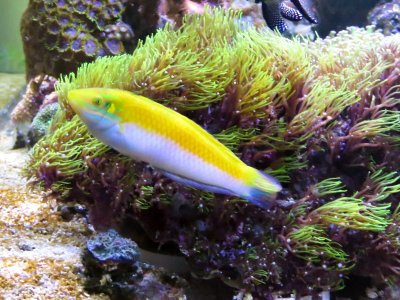
Halichoeres lecoxanthus
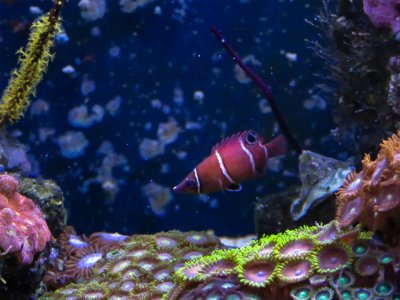
Wetmorella tanakai
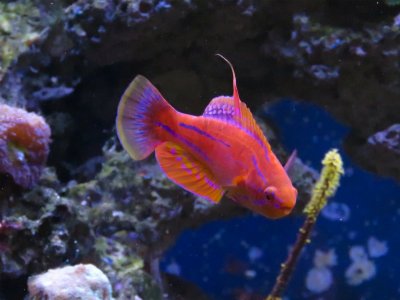
Paracheilinus mccoskeri
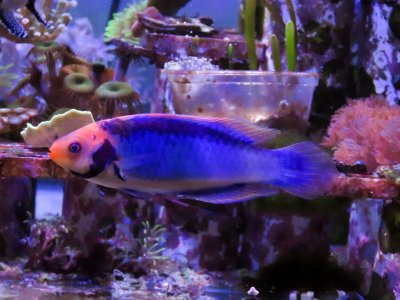
Cirrhilabrus solorensis
(This boy has been exiled to my frag tank, until I can find him a good home. Sadly my mccoskeri and him don't get along)
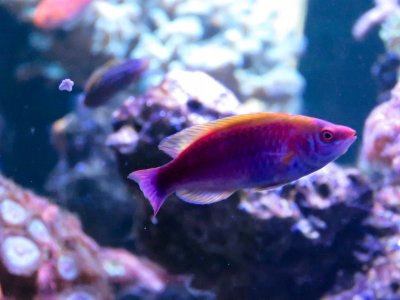
Cirrhilabrus lubbocki
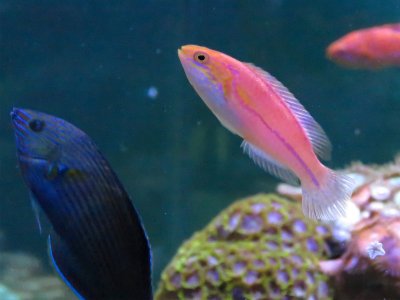
Cirrhilabrus isosceles and Halichoeres marginatus
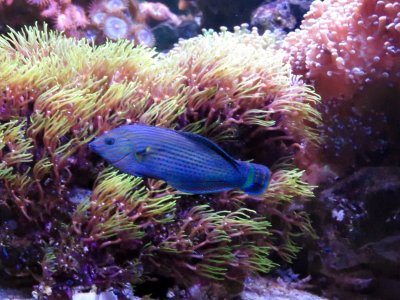
Halichoeres marginatus
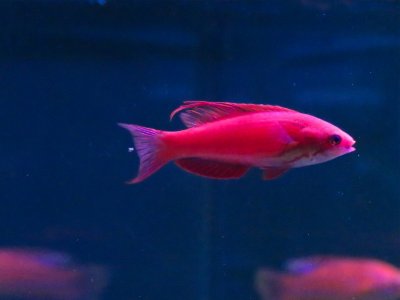
Paracheilinus cyaneus
I also have a Macropharyngodon bipartitus female in QT. She's been in there for 2 months. Shortly after getting her she developed a serious case of "popeye". I'm not sure if it the cause was bacterial, parasitic or physical trauma, but she is finally recovering.









Halichoeres lecoxanthus

Wetmorella tanakai

Paracheilinus mccoskeri

Cirrhilabrus solorensis
(This boy has been exiled to my frag tank, until I can find him a good home. Sadly my mccoskeri and him don't get along)

Cirrhilabrus lubbocki

Cirrhilabrus isosceles and Halichoeres marginatus

Halichoeres marginatus

Paracheilinus cyaneus
I also have a Macropharyngodon bipartitus female in QT. She's been in there for 2 months. Shortly after getting her she developed a serious case of "popeye". I'm not sure if it the cause was bacterial, parasitic or physical trauma, but she is finally recovering.
Last edited:
I also have a question. How likely is it that a female Pencil Wrasse would transition to male, without a male Pencil, but with a bunch of other wrasses for company? I'm thinking about getting a Pseudojuloides xanthomos. The female is about half the price of the male, and I don't mind waiting, but would like her to eventually turn male.
evolved
[email protected]
View Badges
Excellence Award
Reef Tank 365
Expert Contributor
Article Contributor
Moderator Emeritus
AZ FRAG Member
Hospitality Award
My Tank Thread
@eatbreakfast has more experience than I with pencils, but I would say that it would be unlikely for a female pencil to transition in your tank. The transitional males can be prone to reverting even if at all dominated by other wrasses. They really do best as the only wrasses in the tank, or alongside only a few other very peaceful species.I also have a question. How likely is it that a female Pencil Wrasse would transition to male, without a male Pencil, but with a bunch of other wrasses for company? I'm thinking about getting a Pseudojuloides xanthomos. The female is about half the price of the male, and I don't mind waiting, but would like her to eventually turn male.
Similar threads
- Replies
- 8
- Views
- 775
- Replies
- 7
- Views
- 142
















